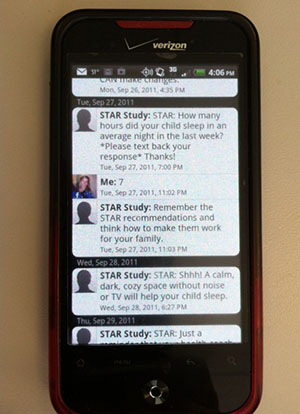STAR is the Study of Technology to Accelerate Research, an obesity intervention for 6 to 13 year old children with a body mass index (BMI) ≥95th percentile. We used mobile and health information technology to help clinicians and parents use evidence-based strategies to improve childhood obesity management. We implemented decision support tools in the electronic health record (EHR) that were delivered to pediatric clinicians at annual patient visits, and health coaches provided direct-to-parent support, including telephone coaching and interactive text messages to enhance these clinical efforts.
STAR was implemented in the pediatric primary care offices of Harvard Vanguard Medical Associates (HVMA). HVMA is a multi-specialty, nonprofit, integrated physician group practice providing pediatric care at 14 sites in eastern Massachusetts. HVMA has a diverse patient population who receive services at a range of suburban and urban practice environments.
Clinical Intervention
Participating clinical practices use a modified EHR that includes a BestPractice® alert that pops up for clinicians at the time of a well child care visit with a child between the ages of 6-13 years with a BMI ≥ 95th percentile. The alert contains links to the CDC growth charts, existing childhood obesity CER evidence, and a pre-populated well child visit template specific for obesity that provides guidance for proper documentation of diagnosis codes and lab orders, as well as a link to patient education materials and a clinician website of obesity-related resources.
We also gave each clinical practice STAR posters to display that summarize the behavioral goals and can cue parents to talk about them with their children and their clinician.
The primary behavioral goals of STAR are:
- Sleep at least 10 hours a night
- No more than 2 hours per day of screen time
- Get at least 1 hour of moderate to vigorous physical per day
- Drink water. Have 0 sugary drinks.
We promote ‘10-2-1-0’ as an easy-to-remember slogan of our goals.
Direct-to-Parent Intervention
In addition to the STAR clinical efforts, we reached out directly to parents. Health coaches conducted calls with parents to assess how children were doing on each of the primary STAR behaviors and to motivate them to work towards the goals. Coaching calls were made four times over the course of one year. Between calls, we mailed parents educational materials on the targeted health behaviors. In addition, parents were invited to participate in a text messaging campaign. For parents who declined the text messaging component, an option was available for an email version of the text messaging system. Texts provided behavior change support for the parent and family. In most weeks, parents received two text messages. One was a self-monitoring message that asked how the child did with a target behavior the day before. Parents were asked to reply to these messages, and immediately received an automated feedback response message tailored to whether the child is meeting the goal, almost to the goal, or far from the goal. The feedback response was further tailored to reflect how they previously reported doing on that particular goal. The second type of message was a skills training, educational tip about one of the target behaviors.


